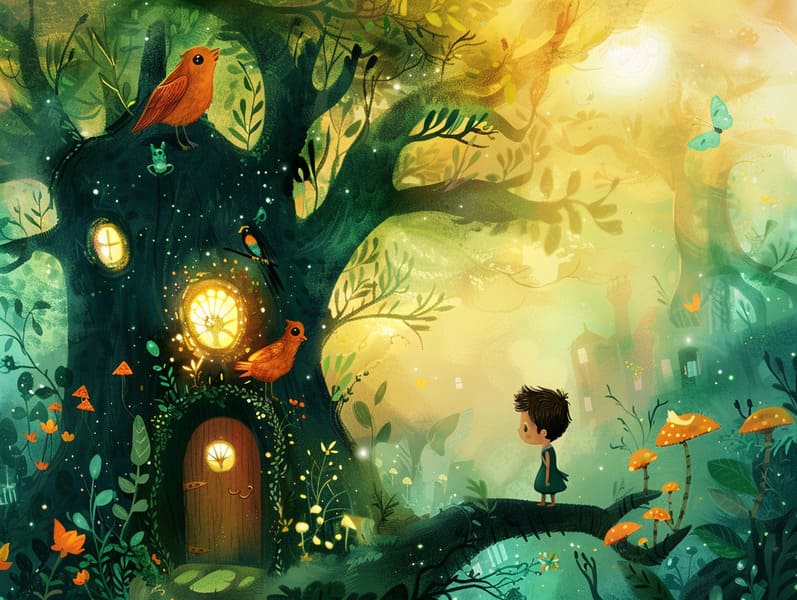The Formation of Online Fairy Tales and Its Ageless Elegance.
The Formation of Online Fairy Tales and Its Ageless Elegance.
Blog Article

Short fairy tales have legendary status. These stories have been recounted from one generation to the next ages before they were ever recorded. They came from a variety of cultures, including Middle Eastern traditions. They were initially passed along among adults, often carrying themes and messages reflective of the societal norms and beliefs of the time.
Jacob and Wilhelm Grimm, Jacob and Wilhelm, were among the first to gather many of these beloved tales. Their anthology, "Grimm's Fairy Stories," included stories like "The Little Glass Slipper," "Hansel and Gretel," and "Little Snow White," which have since become staples in the world of classic fairy tales. Similarly, Hans Andersen's whimsical narratives, such as "The Sea Maid," and "The Ugly Duckling," have floated into hearts worldwide, cementing their place in the pantheon of famous fairy tales.
Despite their age, these stories remain as significant as ever, especially as kids' bedtime tales. These whimsical stories are now available in diverse formats, including colorful picture books, enchanting animations, and internet fairy tales.
Their unwavering allure can be linked to several charming aspects:
Significant Morals: Old fairy tales often whisper important moral lessons. Fairy tales like "The Shepherd Boy and the Wolf" teach the benefit of being truthful, while "The Hare and the Tortoise" underline the traits of perseverance and humility. These stories offer young readers clear distinctions between virtue and vice, helping to shape their moral compass in a gentle yet important way.
Compassion and Knowledge: Timeless fairy tales frequently portray beings facing struggles and tests, motivating kids to comprehend with their struggles and champion their triumphs. For instance, "The Tale of Beauty and the Beast" shows us the necessity of looking beyond appearances to understand the inner core of a person, advancing perception and awareness.
Cultural Knowledge: Many fairy tales are deeply ingrained in the cultural contexts from which they developed. Discovering these tales can provide delightful insights into different cultures, strengthening a sense of cultural appreciation and discernment.
Inventiveness and Imagination: The mythical elements in classic fairy tales—enchanted lands—fuel children’s fantastical thinking. These narratives lead readers to fantasy realms, kindling imaginative thinking and a sense of astonishment that remains a lifetime.
Traditional fairy tales are not only delightful but also teaching. They serve as bewitching tools in enhancing various cognitive and emotional skills in little ones. When traditional fairy tales are spoken, they promote verbal skills by showing new vocabulary and complicated sentence structures. This practice also enhances listening skills and focus, as little ones follow the story, anticipating to see what happens next.
Furthermore, contemplating the themes and characters of fairy tales can nurture logical thinking and intellectual skills. Young readers are shown to discern patterns, guess what will happen, and understand cause and effect. These debates also assist young readers communicate their thoughts and feelings, nurturing their emotional intelligence.
In today’s cyber age, the presence of web-based fairy tales has made these tales more this site obtainable than ever. Digital sites and online apps extend ample collections of bedtime fairy tales that can be read or listened via anytime, anywhere. Fairy tales told out loud are particularly prevalent, extending an interactive method for little ones to appreciate these fascinating tales. Read-aloud books and narrated videos lead characters and settings to life, often augmented by entrancing audio effects and instrumentals that enrich the storytelling journey.
The timeless allure of old fairy tales lies in their ability to evolve to current times while keeping hold of their central messages. Contemporary versions of these fairy tales often bring in more different protagonists and modern settings, making them relevant to today’s audience. However, the key lessons of bravery, kindness, and even-handedness remain unchanged, continuing to affect listeners of all ages.
Fairy tales also offer a sense of solace and recognition. They allow a neat narrative with a definite beginning, middle, and end, often drawing to a close with the settlement of conflicts and the triumph of morality over immorality. This predictability can be calming for kids, making known a sense of assuredness in an constantly changing world.
Traditional fairy tales continue to mesmerize and guide new generations, maintaining their radiance and value in modern society. As bedtime stories for kids, they share a perfect blend of wonder and wisdom, fostering moral values, empathy, and creativity. The presence of online fairy tales and the popularity of fairy tales voiced guarantee that these traditional narratives remain obtainable to new generations.
By defending and disseminating these tales, we continue to laud the rich tapestry of legends and cultural heritage. Whether you are enjoying a beautifully illustrated book, seeing a web-based collection, or listening via an sound book, the majesty of old fairy tales is always within reach. These narratives point out of the unchanging effect of fairy tales and its ability to link us across eras and regions.
Regardless if you are discovering a vividly illustrated book, exploring a internet collection, or hearing an read-aloud book, the enchantment of children's fairy tales is always within reach.
These narratives demonstrate of the enduring impact of narratives and its ability to bind us across generations and cultures, making a tie that enchants and educates alike.